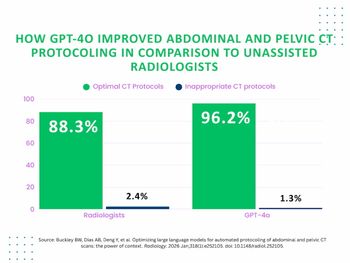
PET/MR products erupt on RSNA exhibit floor
Nearly a decade after PET/CT was first commercialized, vendors at RSNA 2010 took the next logical step and combined MR and PET. The result is unlike anything seen before.
Nearly a decade after PET/CT was first commercialized, vendors at RSNA 2010 took the next logical step and combined MR and PET. The result is unlike anything seen before.
Siemens Healthcare opened this year’s show with its blockbuster full-body PET/MR scanner, dubbed the Biograph mMR. A PET ring detector fitted inside a 3T magnet combine to acquire MR anatomical data and PET functional data simultaneously.
“This is the world’s first fully integrated whole-body molecular MR system,” said Walter Märzendorfer, chief executive officer of Siemens MR, “meaning that a solid-state PET camera is integrated into the isocenter of a 3T MR scanner, allowing simultaneous data acquisition of MR and PET data.”
The data are fused into images that are potentially useful in oncology, pediatric, and neuro imaging and definitely sensational to view. Head-to-toe images show MR and PET data in perfect registration in the brain, down the spine, through the abdomen, and into the extremities.
Philips Healthcare is showing off similarly remarkable results from its Ingenuity TF PET/MR.
“There is no mistaking where the lesion is,” said Dominic Smith, Philips global vice president for CT and nuclear medicine, referring to images of the breast and prostate obtained by investigators in early tests using the experimental Ingenuity TF PET/MR.
Other studies are under way using the experimental system to characterize plaques found in blood vessels, as well as to look at brain anatomy and function.
Although the clinical results are similar, Philips has taken a different design approach than Siemens. As the company did in PET/CT, it has done in this next hybridization, lining up two scanners, one for MR and the other for PET, and connecting the two with a single patient table. Data are acquired sequentially. Patients fitted with MR coils are first examined on the 3T Philips scanner, then conveyed on the patient table into the ring detector of the in-line PET scanner.
The Siemens Biograph mMR, which is prominently featured in the Siemens booth on the RSNA exhibit floor, has been installed at the University Hospital Klinikum rechts der Isar of the Munich Technical University in Germany. It is in near-production form, according to Märzendorfer. The company plans to commercialize its Biograph mMR under a CE label in the European Union in the second half of 2011. Its U.S. launch awaits successful FDA review, which Siemens is currently pursuing.
The in-line Philips system is not yet commercially available in the U.S. and will remain a work-in-progress pending FDA review, according to the company.
Meanwhile, on the RSNA exhibit floor, GE is pressing its own approach to PET/MR, one that has the advantage of being commercially available right now. Images being shown in the GE booth on the exhibit floor are constructed from data acquired during MR and PET exams performed sequentially. A patient table docks with the company’s FDA-cleared MR and PET/CT scanners. Software fuses the data sets from the two exams.
“What we want to show is that when you put these four things together (the two scanners, table, and software), you can combine the power of MR and the power of molecular imaging,” said Vivek Bhatt, GE’s general manager of PET.
Combining just the data rather than the equipment offers a financially responsible solution for the company’s customers, Bhatt said. Freestanding scanners can be used flexibly within a department, applying the PET/CT and MR pieces individually to handle routine clinical cases then using them together to conduct research.
“PET/MR is still in the research realm,” he said. “So the question is, are you going to take very expensive equipment and just have it sitting around for use once in a while when it is needed for research or would you rather have fully 510(k)-cleared systems that you can use to do reimbursable studies and generate cash flow for your site?”
It is a question that only the future can answer.
Newsletter
Stay at the forefront of radiology with the Diagnostic Imaging newsletter, delivering the latest news, clinical insights, and imaging advancements for today’s radiologists.




























